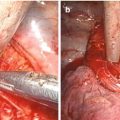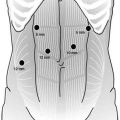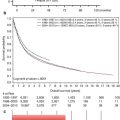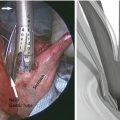Risk factor
Risk
Tobacco
4–8×
Alcohol
1.3–8×
Alcohol dehydrogenase
4×
Fruits and vegetables
0.53–0.56×
Poverty
8×
Gastroesophageal reflux
7.7×
Obesity
3.1×
Helicobacter pylori infection
0.56–1.1×
Squamous Cell Carcinoma
Worldwide squamous cell carcinoma is the most common cancer of the esophagus. Tobacco use, alcohol consumption, genetic abnormalities in the enzymes that metabolize alcohol, caustic injury to the esophagus, infrequent consumption of fruits and vegetables, and poverty have been implicated in the pathogenesis of squamous cell carcinoma (Table 1.2). Each of these risk factors for the development of squamous cell carcinoma of the esophagus will be discussed below.
Table 1.2
Factors involved in the pathogenesis of squamous cell carcinoma of the esophagus
Tobacco smoke –> polycyclic aromatic hydrocarbons and N-nitrosamines –> DNA adducts, methylation, and chromosomal translocations |
Alcohol –> metabolized in liver and oral bacteria –> acetaldehyde –> covalent DNA bonds |
Alcohol –> squamous mucosa cytochrome P450 induction –> reactive oxygen species –> lipid peroxidation and oxidative cell injury –> DNA adducts |
Alcohol dehydrogenase mutation –> inefficient metabolism of alcohol –> increased acetaldehyde in blood stream –> covalent DNA bonds |
Genes affected –> p53, p14ARF, p16INK4a, cyclin D1, EGFR, COX-2, retinoic acid, retinoic acid receptor beta 2, and the fragile histidine triad |
Other factors –> caustic injury due to lye, infrequent consumption of raw fruits and vegetables, poverty |
Tobacco Use and Squamous Cell Carcinoma of the Esophagus
Cigarette smoke contains polycyclic aromatic hydrocarbons and N-nitrosamines, which have been shown to be carcinogenic [12, 13]. Cigarette smoke has a number of other carcinogens, but polycyclic aromatic hydrocarbons and N-nitrosamines are the most important in regard to esophageal squamous cell carcinoma development. The mechanisms of carcinogenesis by tobacco smoke may include formation of DNA adducts, silencing of genes by methylation, and chromosomal translocations [14].
Tobacco smoke causes cancer through the formation of covalent bonds between the carcinogen and cellular DNA, producing DNA adducts. The more DNA adducts formed, the more likely permanent mutations, in genes in cellular division regulating pathways, occur. When DNA adducts are bypassed incorrectly by DNA polymerases, permanent mutation in genes that deregulate cellular division is formed [15, 16].
Hypermethylation of promoters and intragenic hypermethylation can silence the transcription of genes, and DNA translocations can lead to mutational activation or to silencing of growth-regulating genes [17, 18].
A number of genes regulating cellular division have been implicated in the pathogenesis of squamous cell carcinoma of the esophagus. These include p53, p14ARF, p16INK4a, cyclin D1, epidermal growth factor receptors, COX-2, retinoic acid, retinoic acid receptor beta2, and the fragile histidine triad.
P53 is a cellular stress sensor, a tumor suppressor, which normally functions to maintain the integrity of cellular DNA. Loss of function of p53 in esophageal squamous cell carcinoma occurs in approximately 50–60 % of Japanese patients [19–21] making the tumor cells unable to enter into apoptosis or senescence. The tumor cells cannot repair the tobacco-mediated DNA damage, and the result is dysregulated cellular division [22, 23]. P14 ARF blocks MDM2-mediated degradation of p53, leading to increased expression of p53. Tobacco smoke causes the p14ARF promoter to be methylated, silencing expression of p14ARF, which results in decreased p53 expression in about 60 % of patients with esophageal squamous cell carcinoma [24].
Loss of protein expression of the cyclin-dependent kinase inhibitor, p16INK4a, has been observed early in the development of squamous cell carcinoma of the esophagus. This occurs predominantly through loss of heterozygosity of the p16INK4a gene or through silencing of the p16INK4a promoter by methylation [25]. P16INK4a proteins normally function to inhibit cyclin-dependent kinase 4 and cyclin-dependent kinase 6, preventing cellular division. Loss of p16INK4a allows cellular division of squamous cell tumors by allowing the cells to progress unchecked through G1 to S phase of the cell cycle [17].
While p16INK4a normally inhibits cyclin-dependent kinase 4 and cyclin-dependent kinase 6, cyclin D1 activates cyclin-dependent kinase 4/ cyclin-dependent kinase 6 leading to progression through the cell cycle. Tobacco has been shown to increase levels of cyclin D1 in vitro [26], thus, facilitating cell cycle progression.
Other signaling molecules that have been linked to the development of squamous cell carcinoma include overexpression of epidermal growth factor receptors and associated overexpression of COX-2 and Her2/neu overexpression [27–29]. Retinoic acid and retinoic acid receptor beta2 induction can downregulate epidermal growth factor receptor expression. Tobacco smoke can suppress retinoic acid receptor beta2 by methylating the retinoic acid receptor beta2 gene promoters [30]. This may be a tobacco-mediated mechanism contributing to overexpression of epidermal growth factor receptor and, possibly, COX-2 and Her2/neu in squamous cell carcinoma.
The fragile histidine triad gene, encoding a tumor suppressor, has been shown to be inactivated in squamous cell carcinoma of the esophagus [31, 32]. The mechanism of inactivation occurs through silencing of the gene, by promoter methylation, or silencing through genome instability/chromosome translocations [33, 34].
Alcohol Consumption and Squamous Cell Carcinoma of the Esophagus
In the liver, ethanol is metabolized by alcohol dehydrogenase. The acetaldehyde generated by alcohol dehydrogenase has been shown to be carcinogenic in squamous cell carcinoma of the esophagus [35]. Additionally, oral bacteria metabolize ethanol to acetaldehyde resulting in a 10–100 times higher concentration of acetaldehyde in the oral cavity [36, 37]. The acetaldehyde in the saliva comes into direct contact with the squamous mucosa of the esophagus upon swallowing, directly adding to the amount of acetaldehyde that the squamous mucosa is already being exposed to via the blood during alcohol consumption.
Acetaldehyde forms covalent bonds with DNA, and the resulting DNA adducts can escape cellular DNA repair mechanisms causing detrimental mutations in growth-regulating genes [38]. In addition to directly causing mutations in DNA, acetaldehyde indirectly causes DNA mutations by binding to enzymes involved in DNA repair and DNA methylation. Alterations in these enzymes lead to mutations and aberrant regulation of genes [37].
Esophageal squamous mucosa from patients with chronic alcohol consumption demonstrated induction of cytochrome P450 2E1 (CYP2E1) when compared to the squamous mucosa from a teetotaler control group [39]. The cytochrome P450 system generates reactive oxygen species, primarily hydrogen peroxide and superoxide anions. The reactive oxygen species cause lipid peroxidation and other forms of oxidative injury to the cell, which leads to DNA adducts [37, 40]. The resulting DNA adducts can cause permanent mutations.
Chronic alcohol consumption also results in aberrant gene regulation through ineffective promoter methylation (hypomethylation). Alcohol inhibits the synthesis of S-adenosyl-L-methionine, the donor group used for the methylation of promoter regions [41, 42]. Hypomethylated genes can be aberrantly transcribed, dysregulating cellular division [37].
Patients with squamous cell carcinoma of the esophagus, who consumed alcohol more than four times a week, demonstrated decreased levels of retinoic acid receptor gamma in their non-neoplastic squamous mucosa when compared to control patients, who consumed one drink a week or less [43]. Retinoic acid through its receptor’s activation leads to decreased expression of epidermal growth factor receptors. By decreasing retinoic acid receptor expression, alcohol may dysregulate growth by increasing expression and activation of epidermal growth factor receptor signaling pathways.
Alcohol Dehydrogenase Mutation and Squamous Cell Carcinoma of the Esophagus
Ethanol is metabolized into acetaldehyde by alcohol dehydrogenase, and acetaldehyde is further metabolized to acetate by aldehyde dehydrogenase. Prevalent in East Asians are the ADH2*1/2*1 alleles of alcohol dehydrogenase and the ALDH2*2 alleles of aldehyde dehydrogenase [35]. The concentration of acetaldehyde in the bloodstream is increased by both of these enzymes. The ADH2*1/2*1 allele encodes a superactive form of alcohol dehydrogenase producing acetaldehyde quicker. The ALDH2*2 allele of aldehyde dehydrogenase produces an inactive enzyme slowing the removal of acetaldehyde from the blood. The formation of acetaldehyde DNA adducts is mutagenic.
Caustic Injury and Squamous Cell Carcinoma of the Esophagus
The first association of a lye burn and squamous cell carcinoma of the esophagus was reported in 1904 by Telesky [44]. The average interval between a caustic burn to the esophagus and the development of squamous cell carcinoma is approximately 40 years [44]. Chemical injury from a caustic chemical, such as lye, leads to fibrosis with stricture of the esophagus in the area of injury. The narrowed lumen causes an obstruction during swallowing, and the constant irritation leads to repeated injury, inflammation, and repair, which, over time, leads to carcinogenesis. For similar reasons, achalasia is a risk factor for developing squamous cell carcinoma. Why lye injury leads to squamous cell carcinoma and why the caustic injury from acid reflux (to be discussed more below) leads to adenocarcinoma of the esophagus is unclear.
Infrequent Consumption of Raw Fruits and Vegetables and Squamous Cell Carcinoma of the Esophagus
A number of studies [45, 46] have shown an inverse relationship between raw fruit and vegetable consumption and the risk of squamous cell carcinoma of the esophagus. Lower consumption of vegetables and fruits is associated with a higher risk of squamous cell carcinoma. Odds ratios were adjusted for alcohol consumption, tobacco use, and gender. The mechanism of the protective effect of fruit and vegetables is unclear, but it may be related to the vitamins and minerals contained in the foods.
Poverty and Squamous Cell Carcinoma of the Esophagus
The development of squamous cell carcinoma of the esophagus is strongly associated with low income. While the majority of the risk of developing squamous cell carcinoma of the esophagus can be explained by alcohol, tobacco, and low fruit and vegetable intake, low socioeconomic status has an independent effect [47]. Whether this independent effect can be explained by poor dental care or other nutritional or environmental factors needs to be further investigated.
Adenocarcinoma
The incidence of adenocarcinoma of the esophagus has been increasing in Western countries over the last few decades [48]. Environmental factors are most likely to have caused the increase in adenocarcinoma incidence, as it is unlikely that genetic risk/predisposition to adenocarcinoma has changed so abruptly. There is a gender influence on the development of adenocarcinoma of the esophagus, as, in the United States, men are six times more likely to develop esophageal adenocarcinoma than women [48]. Up to 13 % of adenocarcinomas of the esophagus may be due to patients inheriting a genetic predisposition. Genetic predisposition as well as the environmental influences of gastroesophageal reflux disease, obesity, and Helicobacter pylori infection on the development of adenocarcinoma of the esophagus will be discussed.
Genetic Factors and Adenocarcinoma of the Esophagus
Three candidate genes containing germline mutations were identified in patients with esophageal adenocarcinoma: MSR1, ASCC1, and CTHRC1 [49]. MSR1 encodes the class A macrophage scavenger receptor, whose protein function becomes disrupted by the germline mutation. The MSR1 mutation suggests a link between esophageal adenocarcinoma and inflammation. ASCC1 encodes activating signal cointegrator 1, which activates NF kappa B, serum response factor, and activating protein 1 [50]. Therefore, ASCC1 is another signaling molecule putatively linking inflammation to growth signal transduction pathways. Another germline mutation was found in CTHRC1, a protein expressed during tissue repair processes, called collagen triple helix repeat containing 1 protein [51]. CTHRC1 signaling regulates TGF beta pathways, thus, is an additional protein linking inflammation/repair processes to control of cellular proliferation [52].
Patients with a single gene polymorphism in the matrix metalloproteinase gene family, specifically MMP1 1G/2G, have a higher risk of developing esophageal adenocarcinoma [53]. Matrix metalloproteinase proteins are involved in extracellular matrix and basement membrane degradation. A synergistic effect of gastroesophageal reflux disease combined with the MMP1 1G/2G polymorphism increases the risk of developing esophageal adenocarcinoma [53].
A decreased local secretion of epidermal growth factor (EGF) has been associated with the development of esophageal adenocarcinoma [54]. The EGF 5′ UTR G/G genotype confers an increased risk of developing adenocarcinoma and is associated with low EGF levels. Interestingly, epidermal growth factor receptor levels in these patients are overexpressed, possibly caused by lack of an inhibitory effect on EGF receptor expression due to the low circulating EGF hormone levels.
Vascular endothelial growth factor is involved in the regulation of angiogenesis. The variant T allele of the VEGF gene in the +936CT/TT polymorphism is associated with increased risk of esophageal adenocarcinoma, especially in smokers [55]. Carriers of the T allele of VEGF have higher levels of VEGF. VEGF-induced angiogenesis has been shown to be an early event in esophageal adenocarcinoma development [55].
Interleukin-18 is a cytokine, whose inflammatory responses have been linked to antitumor immunity [56]. The single-nucleotide polymorphism, IL-18-607 C/A in its promoter, is associated with the development of Barrett’s esophagus and esophageal adenocarcinoma. Alternatively, the IL-18RAP rs917997C allele is associated with a protective effect on Barrett’s esophagus from developing into adenocarcinoma. The DNA repair protein O(6)-methylguanine-DNA methyltransferase, which repairs DNA adducts, has a variant single-nucleotide polymorphism – rs12268840, when homozygous, which is associated with an increased risk for esophageal adenocarcinoma [57].
Gender Influence and Adenocarcinoma of the Esophagus
Worldwide, there is a male predominance for developing adenocarcinoma. In the United States, the association is even stronger with a 3:1 (Native American) to 9:1 (Caucasian) ratio between men and women [58]. Thus, female sex hormones may have a protective effect. This is supported by the delayed development of adenocarcinoma on average by 17 years in women when compared to men [59]. Another interesting observation is the protective effect of breastfeeding on esophageal adenocarcinoma. Increased duration of breastfeeding is correlated with a reduced risk of developing esophageal adenocarcinoma [60]. More research is required to determine the hormonal mechanisms involved.
Gastroesophageal Reflux Disease and Adenocarcinoma of the Esophagus
Gastroesophageal reflux is an important risk factor for the development of esophageal adenocarcinoma. When compared to the risk of people without reflux symptoms developing adenocarcinoma, an individual experiencing reflux symptoms on a weekly basis has a lower risk of developing adenocarcinoma (5-fold risk) than someone experiencing daily reflux symptoms (7-fold risk) [61]. Reflux of the acid contents of the stomach into the esophagus causes caustic damage to the esophageal squamous mucosa. This leads to injury of the squamous mucosa and acute and chronic inflammation. Repair does not involve scarring as seen with lye but, rather, involves glandular metaplasia (Barrett’s metaplasia) of the esophagus. Barrett’s esophagus is when the squamous mucosa is replaced by intestinal-type glandular epithelium containing goblet cells. Further reflux damage results in further injury with subsequent chronic inflammation and repair. The resulting increased cellular turnover makes the mucosa susceptible to mutations in growth-regulating genes, which leads to glandular dysplasia. Low-grade glandular dysplasia may lead to high-grade glandular dysplasia and esophageal adenocarcinoma [62, 63].
The majority of people with Barrett’s esophagus do not progress to esophageal adenocarcinoma. Neoplastic transformation of Barrett’s esophagus can be difficult to identify, as dysplasia can be focal. Thus, a number of biopsies are required to prevent sampling errors and false-negative results [63, 64]. Low-grade glandular dysplasia has a low rate of progression to esophageal adenocarcinoma [65]. Even high-grade glandular dysplasia progresses to esophageal adenocarcinoma only 10–60 % of the time [66, 67].
The future of predicting which patients with Barrett’s esophagus are at higher risk of progressing to esophageal adenocarcinoma and which have a low risk of progression may be with molecular and chromosomal markers. Chromosome instability, demonstrated by a combined panel of abnormalities encompassing 9p loss of heterozygosity (LOH), 17p LOH, and DNA aneuploidy or DNA tetraploidy in Barrett’s esophagus, predicted subsequent development of esophageal adenocarcinoma, relative risk = 38.7, and a 5-year cumulative risk of developing adenocarcinoma of 79.1 %. Those patients without any demonstrable chromosome instability in their Barrett’s esophagus had 0 % cumulative incidence of adenocarcinoma at 8 years [68]. Molecular markers of chromosome instability in Barrett’s esophagus would be useful to determine patients that would benefit from close clinical surveillance.
Obesity and Adenocarcinoma of the Esophagus
Obesity is a strong risk factor for developing esophageal adenocarcinoma [69]. The risk is even greater for people with central and intra-abdominal obesity [70, 71]. Various mechanisms for obesity-related cancer have been proposed, including increased levels of endogenous sex hormones, leptin, plasminogen activator inhibitor-1, and IGF-1, and decreased adiponectin, and chronic inflammation. This metabolic syndrome caused by obesity has been correlated with length of Barrett’s esophagus [72–74].
Alternatively, instead of being caused by this obesity-related metabolic syndrome, Barrett’s esophagus may be a response to increased acid reflux caused by the increased intra-abdominal pressure due to intra-abdominal obesity. There is a direct correlation between increased body mass index and increased esophageal reflux [75]. The increased esophageal reflux or a combination of risk factors associated with reflux and the metabolic syndrome of obesity may lead to the development of esophageal adenocarcinoma.
Helicobacter Pylori Infection and Adenocarcinoma of the Esophagus
Helicobacter pylori infection occurs in 50 % of the worldwide population and commonly colonizes the stomach of children [76]. Up to a 50 % decrease in esophageal adenocarcinoma risk has been attributed to Helicobacter pylori infection [77]. One possible mechanism includes Helicobacter pylori infection leading to gastric atrophy. The reduction in the acidity and volume of gastric contents leads to an associated decrease in esophageal reflux disease.
Stay updated, free articles. Join our Telegram channel

Full access? Get Clinical Tree








